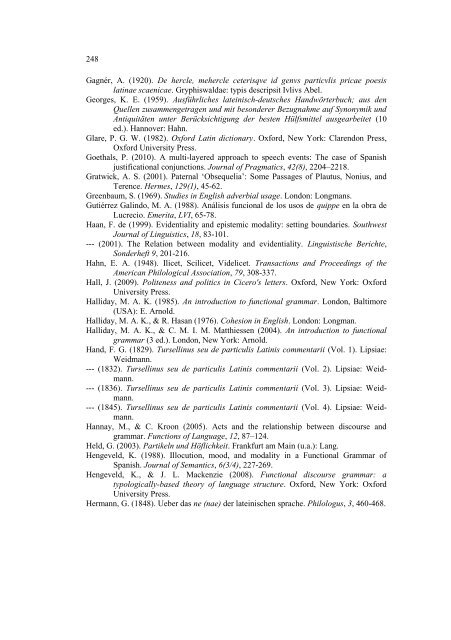Lateinische epistemische Partikeln - VU-DARE Home - Vrije ...
Lateinische epistemische Partikeln - VU-DARE Home - Vrije ...
Lateinische epistemische Partikeln - VU-DARE Home - Vrije ...
Sie wollen auch ein ePaper? Erhöhen Sie die Reichweite Ihrer Titel.
YUMPU macht aus Druck-PDFs automatisch weboptimierte ePaper, die Google liebt.
248<br />
Gagnér, A. (1920). De hercle, mehercle ceterisqve id genvs particvlis pricae poesis<br />
latinae scaenicae. Gryphiswaldae: typis descripsit Ivlivs Abel.<br />
Georges, K. E. (1959). Ausführliches lateinisch-deutsches Handwörterbuch; aus den<br />
Quellen zusammengetragen und mit besonderer Bezugnahme auf Synonymik und<br />
Antiquitäten unter Berücksichtigung der besten Hülfsmittel ausgearbeitet (10<br />
ed.). Hannover: Hahn.<br />
Glare, P. G. W. (1982). Oxford Latin dictionary. Oxford, New York: Clarendon Press,<br />
Oxford University Press.<br />
Goethals, P. (2010). A multi-layered approach to speech events: The case of Spanish<br />
justificational conjunctions. Journal of Pragmatics, 42(8), 2204–2218.<br />
Gratwick, A. S. (2001). Paternal „Obsequelia‟: Some Passages of Plautus, Nonius, and<br />
Terence. Hermes, 129(1), 45-62.<br />
Greenbaum, S. (1969). Studies in English adverbial usage. London: Longmans.<br />
Gutiérrez Galindo, M. A. (1988). Análisis funcional de los usos de quippe en la obra de<br />
Lucrecio. Emerita, LVI, 65-78.<br />
Haan, F. de (1999). Evidentiality and epistemic modality: setting boundaries. Southwest<br />
Journal of Linguistics, 18, 83-101.<br />
--- (2001). The Relation between modality and evidentiality. Linguistische Berichte,<br />
Sonderheft 9, 201-216.<br />
Hahn, E. A. (1948). Ilicet, Scilicet, Videlicet. Transactions and Proceedings of the<br />
American Philological Association, 79, 308-337.<br />
Hall, J. (2009). Politeness and politics in Cicero's letters. Oxford, New York: Oxford<br />
University Press.<br />
Halliday, M. A. K. (1985). An introduction to functional grammar. London, Baltimore<br />
(USA): E. Arnold.<br />
Halliday, M. A. K., & R. Hasan (1976). Cohesion in English. London: Longman.<br />
Halliday, M. A. K., & C. M. I. M. Matthiessen (2004). An introduction to functional<br />
grammar (3 ed.). London, New York: Arnold.<br />
Hand, F. G. (1829). Tursellinus seu de particulis Latinis commentarii (Vol. 1). Lipsiae:<br />
Weidmann.<br />
--- (1832). Tursellinus seu de particulis Latinis commentarii (Vol. 2). Lipsiae: Weidmann.<br />
--- (1836). Tursellinus seu de particulis Latinis commentarii (Vol. 3). Lipsiae: Weidmann.<br />
--- (1845). Tursellinus seu de particulis Latinis commentarii (Vol. 4). Lipsiae: Weidmann.<br />
Hannay, M., & C. Kroon (2005). Acts and the relationship between discourse and<br />
grammar. Functions of Language, 12, 87–124.<br />
Held, G. (2003). <strong>Partikeln</strong> und Höflichkeit. Frankfurt am Main (u.a.): Lang.<br />
Hengeveld, K. (1988). Illocution, mood, and modality in a Functional Grammar of<br />
Spanish. Journal of Semantics, 6(3/4), 227-269.<br />
Hengeveld, K., & J. L. Mackenzie (2008). Functional discourse grammar: a<br />
typologically-based theory of language structure. Oxford, New York: Oxford<br />
University Press.<br />
Hermann, G. (1848). Ueber das ne (nae) der lateinischen sprache. Philologus, 3, 460-468.
















